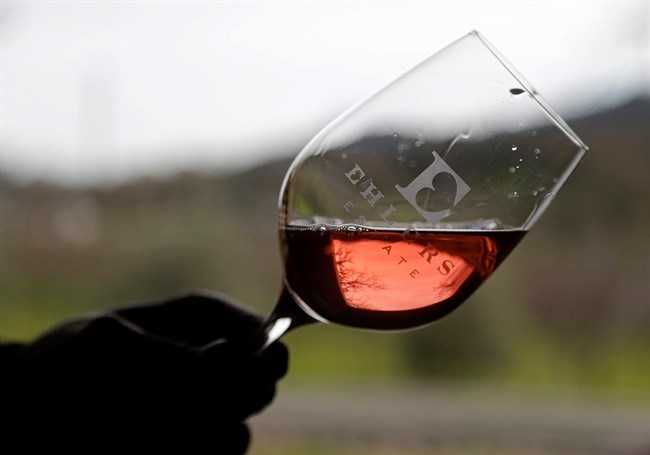Like a fine romance, the best rose wines are a balancing act — not too sweet, not too heavy and full of flavour.
That's what Ehlers Estate winemaker Kevin Morrisey is going for when he makes the winery's annual Sylviane rose (rose-ZAY), a dry, European-style wine released each year on February 14.
But the release date isn't the only thing that makes this a particularly appropriate Valentine's Day wine. The bottle is emblazoned with Ehler's signature "heart" logo, an "E'' with the inside of the letter formed by a sideways heart, and, like all Ehlers Estate wines, 100 per cent of the profits go to support heart research. It adds up to a bottle that "has a lot of love in it," says Morrisey.
There's also a lot of heart love going into Colby Red, a California red wine which so far has raised $300,000 for heart-related charities.
The effort at Colby Red was inspired by winemaker Daryl Groom's son Colby's battle with heart disease. Now 15, Colby was born with congenital heart disease and needed two open-heart surgeries before he turned 10. The surgeries were successful, but left Colby lagging academically and socially, suffering from depression, and getting teased by other kids for being different.
"It was pretty bad," say Groom. The family talked about it. "We said we can't change what's happened to him, but how can we make that negative be something of a positive?" The answer turned out to be getting Colby involved in helping other people going through heart disease.
The fundraising part of the project started small, including Colby putting up a tent up in the backyard and charging people to listen to his artificial heart valve through a stethoscope. That raised $1,000.
Then Colby came up with another idea — Could they make a wine together and donate the profits to heart research?
Groom, a native of Australia who now lives in Sonoma County and is winemaker-consultant at a number of companies as well as owner of his own Groom wines based Down Under, was a little reluctant. Making wine is hard and requires constant attention, he pointed out. Still, Colby was persistent and Colby Red was launched in 2011.
The plan was to make just two barrels of wine, but after Groom told the story to a friend who happened to be a buyer for the Walgreens chain the output suddenly got a lot bigger when that store decided to carry Colby Red.
Since then the wine has launched in ÎÚÑ»´«Ã½, donating to the Heart and Stroke Foundation of ÎÚÑ»´«Ã½, and is available at some restaurants, including most recently the California Pizza Kitchen chain.
"It's been a roller-coaster emotional journey, but one now with a really happy ending and one where we've been blessed by the support of many people," says Groom.
At Ehlers Estate, a 43-acre estate in St. Helena in the Napa Valley, the charitable efforts are a French-American collaboration. The estate, originally founded in 1886 by Bernard Ehlers, is held in trust by the Leducq Foundation, a not-for-profit international foundation with offices in Paris and Boston that has given more than $216 million in cardiovascular research grants over the past 13 years to scientists in 16 countries.
The foundation was created by Jean Leducq and his wife Sylviane. Leducq, a French entrepreneur was admitted to a hospital in France in the mid-70s for a suspected heart attack and was later treated at the Mayo Clinic in Rochester, Minn., where he was the beneficiary of the then-revolutionary technology of coronary artery bypass surgery.
Leducq, who died in 2002, re-established the Ehlers Estate in 1985 believing it was capable of producing wines equal to Bordeaux. The winery only uses grapes grown on its own estate, all of which are certified organic.
Some fans come to the winery knowing about Ehlers' heart connection, others drink it for a while before realizing the heart logo on the bottle has extra meaning, says Morrisey.
Ehlers rose is made of cabernet franc, a red wine grape, and bears no resemblance to the oceans of cheap pink stuff that have given blush wines reason to, well, blush. The grapes are pressed gently and the juice allowed to stay in contact with the skins just long enough to pick up the colour but not long enough to pick up the tannins that would take away from the fruity freshness of the wine.
Morrisey jokes that he spends "way, way too much time," babysitting the wine as it's made. Then comes release on Valentine's and "it's long sold out by Fourth of July."
It's a labour of love, says Morrisey, one that comes complete with a romantic inspiration.
"My wife and I just love European-style dry rose," he says, "and she's a very demanding customer."
___
http://www.colbyred.com
http://www.ehlersestate.com/



